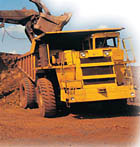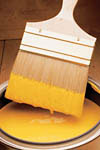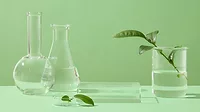Today's Market Demands Affordable Performance
It seems tough competition is the one constant in today’s coatings market. Regardless of what changes take place in the industry, coatings producers are often faced with conflicting agendas. On one hand, they are responsible for continued improvement of their products to maintain a competitive advantage, the cost of which is often significant.

It seems tough competition is the one constant in today’s coatings market. Regardless of what changes take place in the industry, coatings producers are often faced with conflicting agendas. On one hand, they are responsible for continued improvement of their products to maintain a competitive advantage, the cost of which is often significant. On the other hand, they are under tremendous cost pressures to keep their margins healthy. All too often, cost reduction is made at the expense of coating performance. Most new products in the marketplace usually deliver either great performance or good prices, rarely both, thus leaving many paint producers to face the common dilemma of performance versus cost. Obviously, products that deliver cost reduction and performance advantages are sorely desired.
Close inspection of a paint formulation identifies the pigment as one of its more expensive components. Depending on its complexity in manufacturing, its quality and performance, the cost can be greatly elevated. Obviously, using less pigment or switching to a more economical pigment in a formulation would be advantageous from a cost standpoint. The downside is that performance is sacrificed for cost savings.
Despite this gloomy situation there is promising news. Pigment manufacturers are presently addressing this issue by developing high-performance pigments that yield increased value to the formulator. These pigments are designed to perform at peak levels while at the same time keep costs very manageable. They provide affordable performance to the coatings industry.

The product attributes are significant in relation to other products on the market. IRGAZIN Yellow 2088 uniquely offers improved color strength and unparalleled higher opacity. The ability to gain color strength without loss of opacity is a technological breakthrough. As a result, it presents greater flexibility for the coatings producer.
 High Color Strength
High Color Strength
The product’s higher intrinsic color strength (20% or more) enables formulators to reduce the required PY151 loading while maintaining equal color. The tint strength comparison is illustrated in Figure 1. Several industrial coatings manufacturers have confirmation of this color strength advantage in their systems. The lure for manufacturers is that higher strength translates into potential optimization of pigment loadings, reduction of raw material inventories and improved opaque films by blending with inorganics.
Formulators now have the option to either deliver equal color strength and reduce final paint cost or have an improved color strength product unmatched in the marketplace. Suddenly the decision-making process is a favorable one for the coatings manufacturer.
After reducing the pigment formulation to equal strength, IRGAZIN Yellow 2088 is coloristically similar in shade to the competition, as seen in Figure 2.
 High Opacity
High Opacity
The higher opacity will allow formulators to decrease their paint film thickness while still achieving full hiding or opacity. Not only will the formulation cost be decreased due to less pigment, but further reductions will be achieved due to less resin, additives and solvents. If applications constrain film thicknesses, the opacity improvement would deliver paint with a lower pigment concentration. Figure 3 shows the technical opacity advantage.
Opacity is important for formulators because many key industrial shades mandate substrate hiding and gloss. The opacity advantage of IRGAZIN Yellow 2088 delivers a solution for customers’ hiding concerns.

Since the launch of the product in early 2006, several companies have confirmed the opacity and color strength improvements in their systems. One paint formulator, upon testing the IRGAZIN Yellow 2088 sample for a liquid industrial application, cited a 23-36% opacity improvement over other comparable PY151 pigments. The 36% improvement in opacity was over and above Ciba’s initial product claim.
The many benefits of high-performance pigments such as IRGAZIN Yellow 2088 (high opacity, high intrinsic color strength) provide an intriguing opportunity for coatings producers who are struggling with choosing either performance improvements or cost control. Both objectives can now be satisfied through reduced formulation cost and improved hiding with a superior value-in-use pigment.
For more information contact Ciba Specialty Chemicals at 800/431.2360, or visit www.cibasc.com/paintsandcoatings.

It seems tough competition is the one constant in today’s coatings market. Regardless of what changes take place in the industry, coatings producers are often faced with conflicting agendas. On one hand, they are responsible for continued improvement of their products to maintain a competitive advantage, the cost of which is often significant. On the other hand, they are under tremendous cost pressures to keep their margins healthy. All too often, cost reduction is made at the expense of coating performance. Most new products in the marketplace usually deliver either great performance or good prices, rarely both, thus leaving many paint producers to face the common dilemma of performance versus cost. Obviously, products that deliver cost reduction and performance advantages are sorely desired.
Formulator Concerns
For a formulator, product improvements could include new color space, improved color strength, better weathering, better durability or improved opacity. The improvements are achievable through changing pigment chemistries of a high-performance pigment (HPP) or altering other paint components. However, improving the product usually adds cost to the formulation, which would eventually be relayed to the customer. In a competitive marketplace, adding final product cost may not be a realistic option.Close inspection of a paint formulation identifies the pigment as one of its more expensive components. Depending on its complexity in manufacturing, its quality and performance, the cost can be greatly elevated. Obviously, using less pigment or switching to a more economical pigment in a formulation would be advantageous from a cost standpoint. The downside is that performance is sacrificed for cost savings.
Despite this gloomy situation there is promising news. Pigment manufacturers are presently addressing this issue by developing high-performance pigments that yield increased value to the formulator. These pigments are designed to perform at peak levels while at the same time keep costs very manageable. They provide affordable performance to the coatings industry.

A New PY 151 to Aid Formulators
Take for example Pigment Yellow 151. It has traditional applications in liquid industrial, powder and other high-value coatings. It is commonly used in, but not limited to, agricultural, machinery and garden equipment. Ciba Specialty Chemicals’ new PY151 product, Ciba® IRGAZIN® Yellow 2088, accomplishes both of these crucial formulator needs - performance and cost. It also serves as a shading component with Bismuth Vanadate for lead-free applications.The product attributes are significant in relation to other products on the market. IRGAZIN Yellow 2088 uniquely offers improved color strength and unparalleled higher opacity. The ability to gain color strength without loss of opacity is a technological breakthrough. As a result, it presents greater flexibility for the coatings producer.

The product’s higher intrinsic color strength (20% or more) enables formulators to reduce the required PY151 loading while maintaining equal color. The tint strength comparison is illustrated in Figure 1. Several industrial coatings manufacturers have confirmation of this color strength advantage in their systems. The lure for manufacturers is that higher strength translates into potential optimization of pigment loadings, reduction of raw material inventories and improved opaque films by blending with inorganics.
Formulators now have the option to either deliver equal color strength and reduce final paint cost or have an improved color strength product unmatched in the marketplace. Suddenly the decision-making process is a favorable one for the coatings manufacturer.
After reducing the pigment formulation to equal strength, IRGAZIN Yellow 2088 is coloristically similar in shade to the competition, as seen in Figure 2.

The higher opacity will allow formulators to decrease their paint film thickness while still achieving full hiding or opacity. Not only will the formulation cost be decreased due to less pigment, but further reductions will be achieved due to less resin, additives and solvents. If applications constrain film thicknesses, the opacity improvement would deliver paint with a lower pigment concentration. Figure 3 shows the technical opacity advantage.
Opacity is important for formulators because many key industrial shades mandate substrate hiding and gloss. The opacity advantage of IRGAZIN Yellow 2088 delivers a solution for customers’ hiding concerns.

Customer Comments
“Ciba IRGAZIN Yellow 2088 exhibits 20% to 30% higher intrinsic color strength against other market leaders,” says Chuck Johnson, industry manager, Ciba Business Line Coatings in NAFTA. “And the high opacity makes it easier for formulators to reach their desired shade using substantially less pigment.”Since the launch of the product in early 2006, several companies have confirmed the opacity and color strength improvements in their systems. One paint formulator, upon testing the IRGAZIN Yellow 2088 sample for a liquid industrial application, cited a 23-36% opacity improvement over other comparable PY151 pigments. The 36% improvement in opacity was over and above Ciba’s initial product claim.
Conclusion
Ultimately, the decision to switch from standard PY151 products to high-performance products such as IRGAZIN Yellow 2088 is up to what each formulator’s financial and performance goals dictate. Lowering pigment loading and opting for thinner films could reduce coating producers’ formulation costs by 30%, making reformulation an easy decision.The many benefits of high-performance pigments such as IRGAZIN Yellow 2088 (high opacity, high intrinsic color strength) provide an intriguing opportunity for coatings producers who are struggling with choosing either performance improvements or cost control. Both objectives can now be satisfied through reduced formulation cost and improved hiding with a superior value-in-use pigment.
For more information contact Ciba Specialty Chemicals at 800/431.2360, or visit www.cibasc.com/paintsandcoatings.
Looking for a reprint of this article?
From high-res PDFs to custom plaques, order your copy today!





